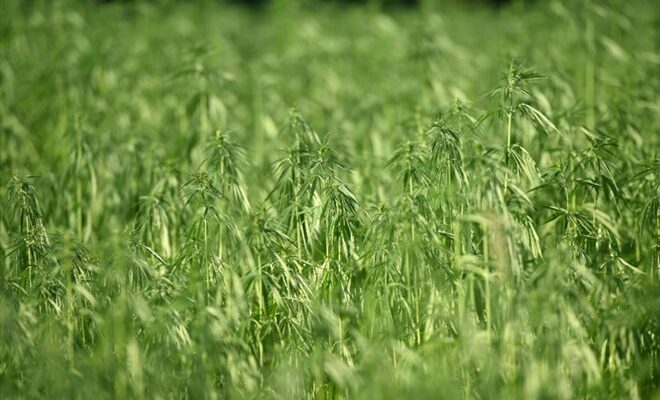Compressed hemp insulation at Planète hemp during an exhibition dedicated to industrial opportunities for hemp, on September 17, 2019 in Aulnoy (AFP/Archives/Philippe LOPEZ)
“No need to weed, it grows very quickly by smothering the weeds”: Olivier Schintgen, a cereal farmer on 187 hectares in Essonne, discovered the cultivation of organic hemp three years ago, and he became addicted.
For building insulation, hemp, straw and wood are booming in France.
Despite their still high cost, these biosourced products are in high demand to replace plastic or mineral materials (polystyrene, rock wool, glass wool).
They thus contribute to reducing the energy consumption of buildings and to decarbonizing construction, a sector which emits nearly 40% of global CO2 emissions responsible for global warming.
But while France had up to 176,000 hectares of hemp cultivated around 1830, used mainly in the textile industry, it only has 23,145 today, exploited by 1,550 farmers throughout the country, or 0.3 % of French farmers mainly in the Grand Est, Vendée, Seine-et-Marne and Haute-Saône.
A very small agricultural sector, but in full renaissance: “In the 60s and 70s, we had reached 300 hectares of hemp at the lowest”, consoles Franck Barbier, farmer and president of InterChanvre, the inter-professional sector of the sector created in 2003.
On the surface, France is now ranked 3rd in the world, behind China and Canada, underlines Interchanvre, which organized a meeting with the press this week as part of the Agricultural Show in Paris.
Areas within the European Union amounted to 58,257 hectares in 2022, with France holding more than a third of the total, followed by Germany far behind, with only 6,943 hectares.
– 15 t of CO2/ha –
In addition to its capacity as a carbon sink capturing 15 tonnes of CO2 per hectare, farmers are especially attracted by the agronomic interest of the plant “which leaves the fields clean”, is “water-saving” and makes it possible to “avoid the use of fungicides, herbicides and insecticides”, emphasizes Mr. Schintgen.
The mayor of Trilport in Seine-et-Marne, Jean-Michel Morer has defended the sector since 2009. He was one of the pioneers of eco-districts designed from biosourced materials (wood, hemp, etc.) and local materials.
“My region was heavily polluted by atrazine for years,” a dangerous systemic herbicide now banned, “and I was looking for how to make agriculture cleaner without depleting the soil,” he explains to AFP.
“Everything can be used in this plant,” he exclaims: the seed is used for edible oil or cosmetics, the inner stem (or hemp) is used to make hemp concrete and animal bedding. or horticultural mulching, and the straw or fiber is used to make building insulation, is used in the textile industry, automotive plastics (for car interior trim), and especially in stationery, its historical outlet.

A hemp field, whose outlets range from textiles to construction to food and cosmetics, in Saint-Agnet in the southwest of France on July 11, 2022 (AFP/Archives/GAIZKA IROZ)
But the income remains lower than wheat or cereals, especially since there is no world market price, admits Joël Lagneau of Interchanvre.
“So that the price is attractive and encourages farmers to sow hemp, we are increasing their remuneration to secure our supplies,” explains Arthur Cordelier, carpenter and general manager of the young company Wall Up, created in 2019, in Aulnoy (Seine- et-Marne). Wall Up has invented a concept of pre-fabricated wooden frame insulating panel, filled with hemp insulation, for construction.
Another obstacle to development is the lack of processing tools, factories or cooperatives, which are close to agricultural operations. France has only seven hemp farms.
One of the best known, Cavac in Vendée, is in the process of tripling its production capacity after an investment of nearly 30 million euros, as is Planète Chanvre in Seine-et-Marne. In Essonne, Gatichanvre invested 3 million euros to restart its factory, explains Delphin Pallu, its director.
To develop cultivation even further, the sector hopes to “obtain a green light from Brussels” so that hemp benefits from subsidies from the common agricultural policy (CAP) known as “for environmental services” or so that it can be produced on fallow land, “since it does not need any pesticides,” explains Franck Barbier. “Our goal is to reach 45,000 hectares by 2027.”
© 2024 AFP
Did you like this article ? Share it with your friends using the buttons below.




